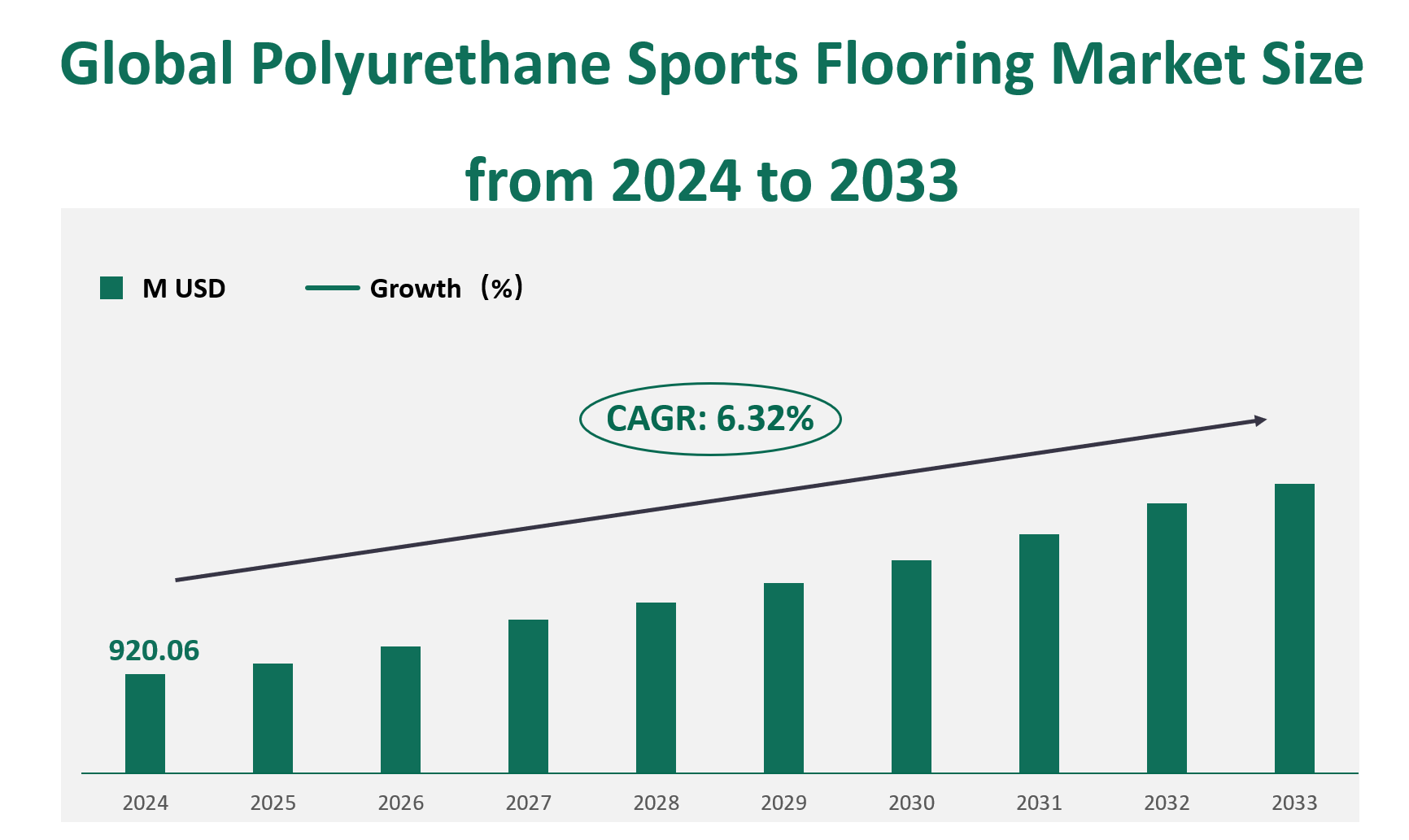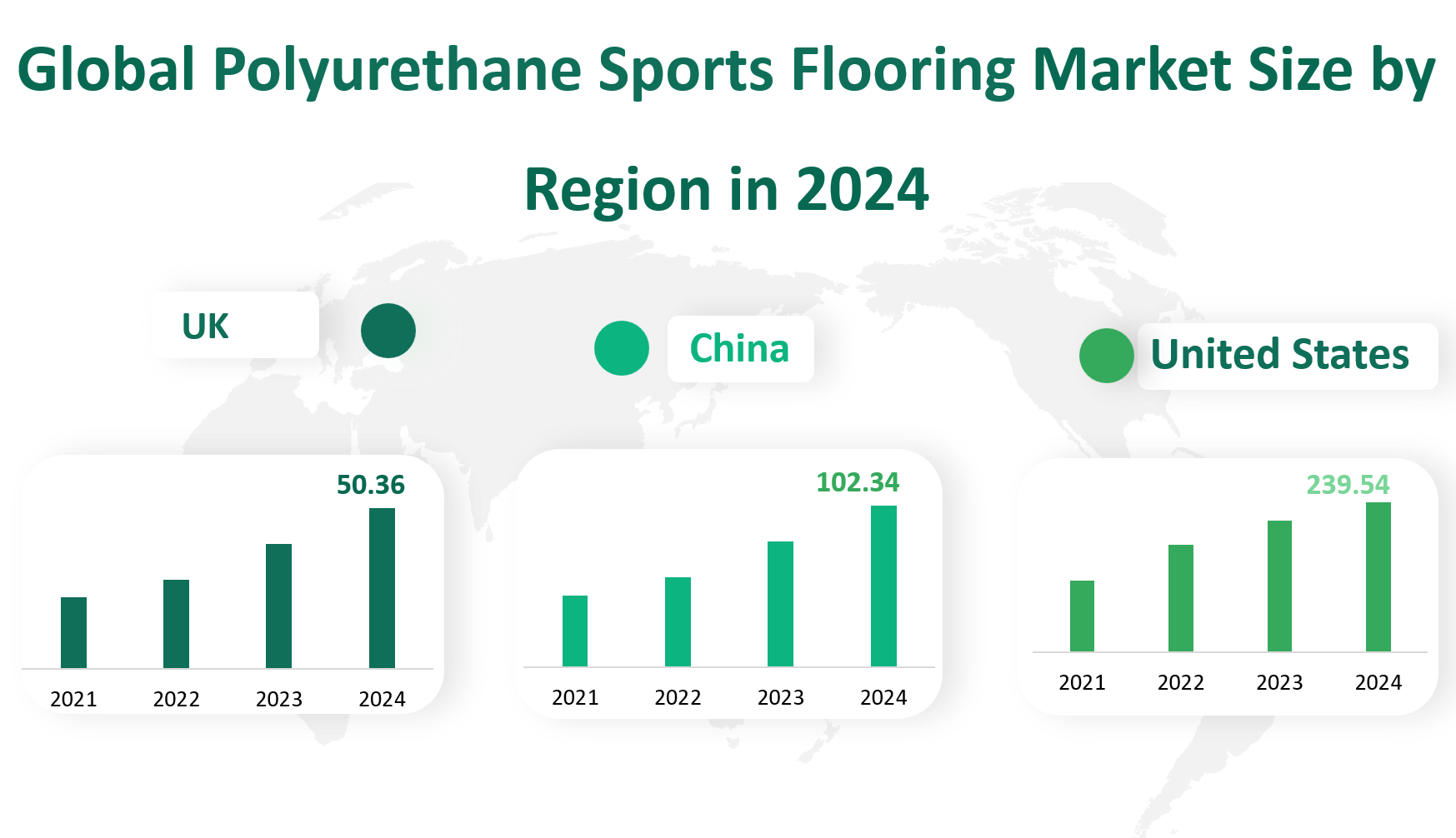1. Global Polyurethane Sports Flooring Market Insight Analysis
The global Polyurethane Sports Flooring market is a significant segment within the broader sports infrastructure industry, valued at approximately 920.06 million USD in 2024. This market is projected to grow at a Compound Annual Growth Rate (CAGR) of 6.32% over the next few years, driven by increasing demand for high-performance sports flooring solutions across various applications.
Polyurethane Sports Flooring is a high-performance flooring solution designed to meet the rigorous demands of sports and recreational activities. It is engineered to provide excellent shock absorption, durability, and resistance to wear, making it ideal for use in various sports facilities such as stadiums, school gyms, fitness centers, and more. Polyurethane flooring is known for its ability to withstand heavy foot traffic, extreme weather conditions, and repeated use without significant degradation. The material is typically composed of polyurethane, a versatile polymer known for its elasticity and toughness.
Figure Global Polyurethane Sports Flooring Market Size (M USD) and CAGR (2024-2033)

2. Driving and Limiting Factors of Polyurethane Sports Flooring Market Growth
The growth of the Polyurethane Sports Flooring market is driven by several key factors. First, the increasing demand for high-quality sports infrastructure across the globe is a major driver. As countries invest in developing sports facilities to support professional and amateur sports, the need for durable and performance-enhancing flooring solutions grows.
Additionally, the rising popularity of fitness and sports activities has led to an increase in the construction of new gyms and fitness centers, further boosting the demand for Polyurethane Sports Flooring. Technological advancements in the production of polyurethane materials have also played a crucial role. Innovations in manufacturing processes have led to the development of more durable, environmentally friendly, and cost-effective flooring solutions. These advancements not only enhance the performance of the flooring but also reduce maintenance costs and extend the product’s lifespan.
Another driving factor is the increasing awareness of the benefits of polyurethane flooring, such as its ability to reduce injuries and improve overall sports performance. As more facilities recognize these advantages, they are more likely to invest in polyurethane flooring solutions.
Finally, government support and policies aimed at promoting sports and physical activity have also contributed to the market’s growth. Initiatives such as the construction of public sports facilities and the promotion of sports tourism have created additional opportunities for the Polyurethane Sports Flooring market.
One of the primary limiting factors is the high initial investment required for the installation of polyurethane flooring. The cost of raw materials, such as polymeric MDI and TDI, can be prohibitive for some facilities, especially smaller ones.
Additionally, the installation process requires specialized skills and equipment, which can further increase costs. Another challenge is the environmental impact of polyurethane production. While advancements have led to more eco-friendly formulations, concerns about the environmental footprint of polyurethane materials still exist. This has led some facilities to explore alternative flooring solutions that are perceived as more sustainable.
Market competition is also a significant factor. The Polyurethane Sports Flooring market is highly concentrated, with a few major players dominating the industry. New entrants may find it difficult to penetrate the market without significant investment in research and development, marketing, and distribution.
Finally, economic uncertainties and fluctuations in raw material prices can impact the market’s growth. These factors can lead to delays in construction projects and reduced demand for high-end flooring solutions.
3. Technology Innovation in Polyurethane Sports Flooring Market
Enhanced Durability and Performance: Modern polyurethane sports flooring formulations incorporate advanced polymers and additives that significantly improve the durability, shock absorption, and wear resistance of the flooring. For example, the use of diphenylmethane diisocyanate (MDI) has become mainstream due to its low volatility and toxicity compared to traditional toluene diisocyanate (TDI). MDI-based formulations offer better adhesion, reduced environmental impact, and improved physical properties.
Customizable Solutions: Innovations in polymer chemistry allow manufacturers to tailor the properties of polyurethane flooring to specific applications. For instance, formulations can be adjusted to provide varying levels of flexibility, hardness, and slip resistance, making the flooring suitable for everything from high-impact sports arenas to sensitive gym environments.
Efficient Installation Processes: Polyurethane sports flooring is often installed on-site using liquid rubber or precast systems. Recent advancements in installation techniques have reduced curing times and improved the consistency of the final product. For example, modern polyurethane foams can achieve initial strength within a few hours, allowing for faster construction and reduced downtime.
Sustainable Practices: Innovations in on-site construction have also focused on sustainability. For instance, the use of recycled rubber granules and eco-friendly binders has become more prevalent. These practices not only reduce the environmental footprint of the flooring but also enhance its performance characteristics.
4. Global Polyurethane Sports Flooring Market Size by Type
Polyurethane sports flooring is categorized based on thickness, with the primary types being 10-14mm, 14-15mm, 15-16mm, and other thicknesses.
Thickness 10-14mm of flooring is designed for general sports applications, providing a balance between durability and flexibility. It is commonly used in school gyms, fitness centers, and smaller sports facilities. The market value for this thickness segment is projected to reach 313.76 million USD in 2024.
Thickness 14-15mm flooring is designed for more demanding applications, such as professional sports arenas and high-traffic areas. It offers enhanced durability and shock absorption. The market value for this segment is estimated at 319.37 million USD in 2024.
Thickness 15-16mm is the thickest category of polyurethane sports flooring, designed for heavy-duty applications such as international sports events and high-performance training facilities. It provides superior shock absorption and long-term durability. The market value for this segment is projected to be 163.88 million USD in 2024.
Table Global Polyurethane Sports Flooring Market Size by Type in 2024
Market Size (M USD) 2024 | |
Thickness 10-14mm | 313.76 |
Thickness 14-15mm | 319.37 |
Thickness 15-16mm | 163.88 |
Others | 123.05 |
5. Global Polyurethane Sports Flooring Market Size by Application
Stadiums are large, multi-purpose venues designed for hosting sports events, concerts, and other large gatherings. Polyurethane flooring in stadiums must withstand heavy use and provide optimal performance for athletes. The market value for stadiums application is projected to reach 464.63 million USD in 2024.
School gyms are facilities within educational institutions used for physical education, sports competitions, and other activities. The flooring in these areas must be durable, safe, and easy to maintain. The market value for this application is estimated at 246.91 million USD in 2024.
Fitness centers are facilities equipped with exercise machines, free weights, and other fitness equipment. Polyurethane flooring in these centers provides a safe, non-slip surface for various exercises. The market value for fitness centers is projected to be 121.05 million USD in 2024.
Table Global Polyurethane Sports Flooring Market Size by Application in 2024
Application | Market Size (M USD) 2024 |
Stadium | 464.63 |
School Gym | 246.91 |
Fitness Centers | 121.05 |
Others | 87.47 |
6. Global Polyurethane Sports Flooring Market by Top Regions
United States is expected to remain a significant market for Polyurethane Sports Flooring in 2024. The region’s market value is projected to be around 239.54 million USD. The market in United States benefits from a well-established sports infrastructure and a strong focus on athletic activities. Additionally, the presence of key players such as Sport Group and Hellas Construction, which have a significant market share in the region, further supports the growth of the Polyurethane Sports Flooring market. The region’s market value is also influenced by technological advancements and the adoption of high-performance flooring solutions that meet international standards.
Germany is another major market for Polyurethane Sports Flooring, with a projected market value of around 65.61 million USD in 2024. The region’s market is characterized by a high demand for quality sports flooring solutions, driven by the presence of numerous sports events and the need for durable and high-performance flooring. The presence of companies such as Tarkett and Stockmeier Urethanes, which have a strong market presence in the region, further supports the growth of the Polyurethane Sports Flooring market.
The China is expected to be one of the fastest-growing markets for Polyurethane Sports Flooring in 2024, with a projected market value of around 102.34 million USD. The increasing demand for sports flooring in stadiums, school gyms, and fitness centers, along with the growing popularity of sports activities, is driving the market value in the region. The region’s market value is also influenced by the increasing adoption of advanced polyurethane materials and the growing focus on improving sports facilities to meet international standards.
Figure Global Polyurethane Sports Flooring Market Size by Region in 2024

7. Global Polyurethane Sports Flooring Market Analysis by Major Players
7.1 Sport Group
Introduction and Business Overview: Sport Group is a global leader in the design, installation, and maintenance of sports surfaces. Established in 1966, the company operates worldwide and offers a comprehensive range of products and services for sports and recreational facilities.
Products: Sport Group specializes in polyurethane sports flooring, including products like Rekortan PUR, which is a World Athletics certified, 15mm, impermeable, full-pour system designed for high-performance sports applications.
7.2 Tarkett
Introduction and Business Overview: Tarkett is a worldwide leader in innovative flooring solutions, with a history spanning over 140 years. The company offers a wide range of products, including polyurethane sports flooring, and serves customers in over 100 countries.
Products: Tarkett’s polyurethane sports flooring includes systems like BSS 100 and BSS 300, which are designed for various sports applications, including running tracks and multi-purpose sports facilities.
7.3 Stockmeier Urethanes
Introduction and Business Overview: Stockmeier Urethanes is a specialist in polyurethane systems, with a focus on the development and manufacturing of coatings, adhesives, sealants, and elastomers for sports and industrial markets. Established in 1991, the company operates worldwide with production facilities in Germany, France, the UK, and the US.
Products: Stockmeier Urethanes offers a range of polyurethane floor systems suitable for sports and leisure centers, including running tracks, tennis courts, and multi-purpose sports halls.

